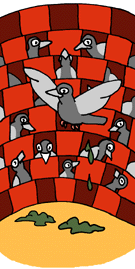|
RBH Home
Maps & Travels
Articles
Legends
Towns & Villages
Castles & Houses
Churches
Biographies
Gentry
Family History
Odds & Ends
For Kids
Teacher's Page
Mail David

|
|

Where Monks kept their Dinner
 |
- This is where the monks kept doves or
pigeons.
- They could be round or square. Sometimes
they were built into barns.
- They always had inside walls covered with
little holes or niches where the birds could nest.
- The birds got in through a slatted turret
at the top.
- The monks kept pigeons to eat them. They
were a good source of fresh meat, particularly in the winter.
- The monks were supposed to be
vegetarians. The abbot often let them eat pigeon though.
- The abbot was allowed to eat meat because
he often had important guests to entertain.
- Of Berkshire's monastic dovecotes, only
the one at Hurley Priory has survived.
- Manor Houses and big farms could have
dovecotes too. Several still exist in Berkshire; like at Coley
Park, Bisham
Abbey Manor, Pigeon House Farm in Eastbury, the manor at Long
Wittenham or the two in Marcham.
- The nearest dovecotes open to the public
are at Basing House in Hampshire and Minster Lovell Hall in
Oxfordshire.
|
|



